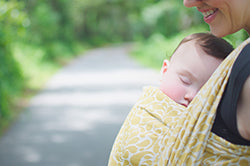Safety
YOUR CHILD'S SAFETY IS YOUR OWN RESPONSIBILITY.
You should not attempt to carry a child in a wrap or sling until you feel confident in your wrapping abilities. Consult a certified VBE (Volunteer Babywearing Expert) in your area if you need help.
Please read the guidelines below for our recommendations for safe use. We cannot be held liable for accidents that may occur as a result of misusing your wrap or sling.
Babywearing keeps your baby visible and kissable!
The practice of babywearing keeps babies in the safest place possible: a parent’s arms, with baby’s face visible to the carrying adult. Babies are especially vulnerable in their first four months of life and require constant supervision. This is why babywearing can be so beneficial to infants’ well-being, while allowing parents to move around and accomplish tasks.
Baby carriers are meant to mimic in-arms carrying positions. Your baby should be in the same position in which you would hold him in your arms: upright and close to your body. Check baby’s position by hugging him or her after settling baby into the carrier. Your child’s position should not shift significantly in your embrace. The top of baby’s head should be at an easy height to kiss.
Safety Checklist
When using any baby carrier, please keep the following safety tips in mind:
-
Read and follow all manufacturer’s instructions for use.
-
Always inspect your wrap for signs of damage or weaknesses before use.
-
Always use common sense when wrapping your child.
-
Ensure you can see baby’s face at all times. Do not let baby’s face press into your body. Make sure that at least one of baby’s nostrils is completely clear by turning baby’s head gently to the side if necessary. Do not cover baby’s face with anything, including blankets, sling fabric, and nursing covers.
-
Baby’s head and neck must be gently and completely supported, with chin off chest. If baby’s chin is pressed tightly to baby’s chest, this can restrict baby’s airway. Ensure you can slip your finger between baby’s chin and chest to check for correct positioning.
-
Consult an expert if your infant was born with a low birth weight (for example, if baby was a preemie or a twin) or has respiratory illness or other respiratory problems. These conditions require extra vigilance.
-
After nursing in a carrier, remove baby from breast and return baby to proper carrying position. Baby’s head should be above the breast (at mother’s collarbone height), and baby’s face should be free of fabric and turned to the side rather than pressing into the mother’s body.
-
Attend to and check on baby often, especially when baby is under six months of age.
-
Remain aware of your child’s body temperature. You and your baby share each other’s body heat, and the wrap provides additional warmth to baby. You may wish to dress baby in slightly lighter layers than you yourself are wearing.
-
Never wear your child while in a moving vehicle.
-
Use caution and always support baby with your hands when bending or leaning forward.

